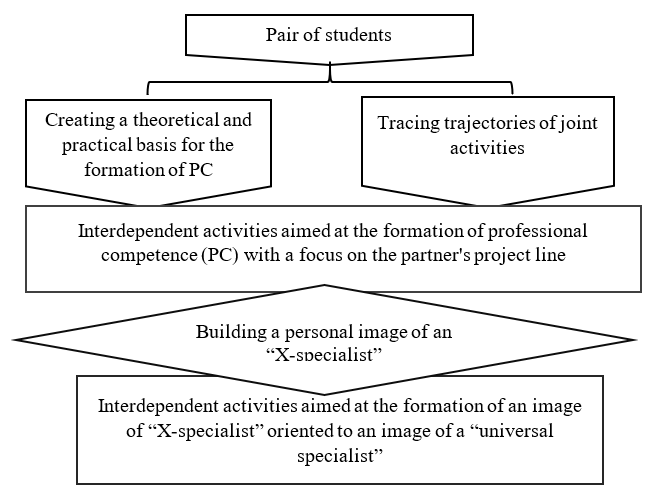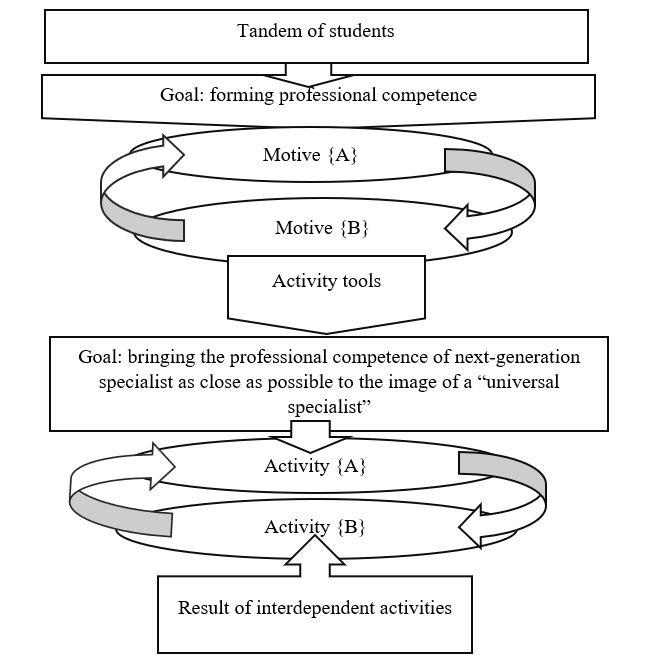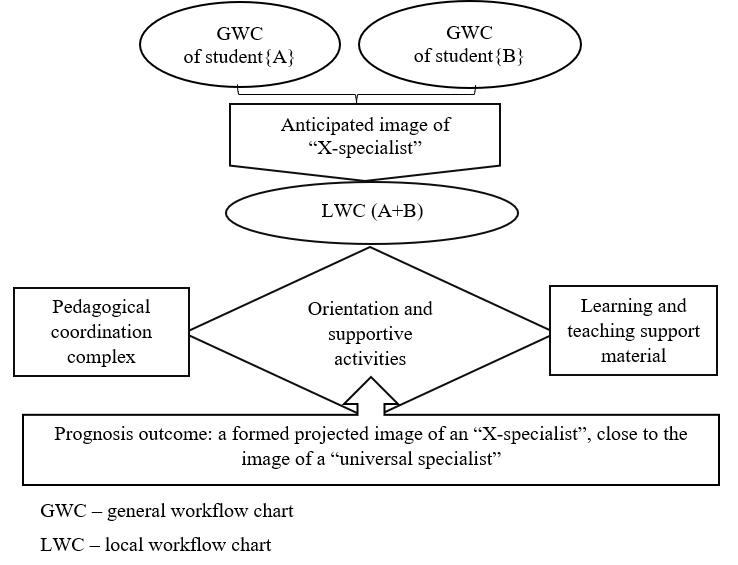PROCEDURAL COMPONENT OF TANDEM SELF-PROJECTION TECHNOLOGY
PROCEDURAL COMPONENT OF TANDEM SELF-PROJECTION TECHNOLOGY
Abstract
Procedural component is one of the key aspects in the development of any educational technology. For an efficient implementation and high-quality realisation of a technology in educational process, it is therefore necessary to clearly understand the content and structure of the procedural component. In this paper, the author describes the procedural component of tandem self-projection technology; in interdependent activities aimed at the formation of professional competences, this technology is used by students to help each other overcome educational barriers, thereby bringing their professional selves closer to the image of a “universal specialist”. The purpose of the study is to present to the scientific community the substantive basis of the procedural component of this educational technology. We believe that understanding this basis will create conditions for the effective implementation of tandem self-projection in professional training process.
1. Introduction
Recent decades have seen numerous innovative technologies be implemented in vocational training. It is thus possible to select a convenient training format from a broad range of options. This was the conclusion we made after studying works of such scientists as M.I. Azarenkova, O.L. Altshuler-Ferreira, E.G. Zueva, D.S. Kungurtseva, S.L. Suvorova, N.S. Shilovskaya, O. A. Sizova, G. A. Kazantseva, and others.
For example, according to O.L. Altshuler-Ferreira, educational technology, as introduced into educational process, determines a platform, where unique experience can be gained, and promotes personal involvement and interest in professional development .
E.G. Zueva considers information technology as a factor determining the formation of “hard skills” (which include professional competences and technical skills, according to the author) and “soft skills” expressed in practical and person-specific qualities of a future specialist .
D.S. Kungurtseva and K.Y. Glukh present innovative educational technologies as a set of methods and means "... that support all stages of the implementation of new practices related to innovative activities", which will, in our opinion, project creativity of professional activity in the future .
S.L. Suvorova explores scenario-type educational technologies enabling to "...model real situations of professional interaction...", which, according to the author, "...is instrumental in the development of teachers' creative thinking and their pedagogical professionalism" .
A group of scientists (N.S. Shilovskaya, O.A. Sizova, and G.A. Kazantseva) is working on theatrical technologies in education and consider them as a kind of pedagogical technologies, built around a system of theatrical and pedagogical methods and techniques aimed at achieving pedagogical goals .
In our opinion, the trend for presenting various technologies to students should contribute to the effective formation of creative next-generation specialists, flexible against rapidly changing socio-economic conditions and easily switching between different types of professional activities; in other words, to the formation of competent specialists, namely, “universal specialists” in various fields.
In higher education, one of the technologies which allows the formation of specialists meeting social demands is the tandem self-projection technique.
The essence of this technology is to determine the trajectories of joint formation of professional competence (PC) components, where each partner is supposed to align himself with his partner's project line, with interrelated actions being co-operatively developed within the framework of orientation and supportive activities in order to eliminate learning barriers and strengthen the existing bases of PC.
The purpose of the technology is to help a partner to minimise the differences between the degrees of formation of his/her professional competence components and bring the «X–specialist» image closer to the «universal specialist» image.
2. Main results
An efficient implementation and realisation of the above-mentioned technology is possible only with the help of its procedural component, which can be characterised in terms of motivational component, organisational form, and tandem self-projection management.
The motivational component is a mechanism which is crucial to better understand the strategy of tandem self-projection and, consequently, make it progress during the whole joint activity.
A special feature of this mechanism is that the tandem independently models its motivational base for joint activities.
A distinctive feature of the motivational aspect is that in the course of interdependent activities, each partner considers himself with his mate an organic whole, identifying himself with the partner, i.e., subordinates’ personal interests to the interests of joint activities. In this situation, the partners take responsibility for each other, tackling mutual problems and difficulties in order to provide timely, interdependent assistance in their solution.
Motivational component protects the pair from external influences, promoting an efficient work in tandem.
This component of educational activity implies the variation of such characteristics of partners as motives, perception, and the evaluation system, because each of them expands their attention by prognosing the behaviour of their partner.
We believe that motivational aspect is the basis for a more efficient and active behaviour of each partner of tandem, causing a significant activation of thinking ability and increasing the tandem’s creative potential.
The organisational form of the procedural component of education technology is determined both by the model of pair’s interdependent activities and by the interconnection of the components of these activities.

Figure 1 - Tandem self-projection structure

Figure 2 - Model of interdependent activities
The goal of tandem self-projection is to bring professional competence as close as possible to the image of a “universal specialist”.
Motive is an internal force driving the engagement into necessary activities. In interdependent activities, motives create and enrich the trajectories of joint activity.
The result-oriented activity toolkit consists of special methods and practices of joint actions, as selected by students.
A result is what each participant achieves in the process of joint activity.
The essence of interdependent activities is active, mutually influencing actions of process participants, which lay the basis for joint educational pathways that form levels of awareness and levels of creation of own image of an “X‒specialist”. They also trace trajectories for correcting images oriented to the image of a “universal specialist”. Characteristic features of interdependent activities are:
– conscious nature: a tandem consciously formulates goals for joint activity with a focus on the end result, and works out the most appropriate trajectories and pathways to achieve them;
– transformative nature: partners interact through specially developed individual tools and techniques that transform and enhance the options of each participant of the process;
– productive nature: interdependent activities are aimed at the final result (i.e., understanding and creation of the appropriate image of an “X-professional”, close to the image of a “universal specialist”).
Efficiency of practical realisation of joint activity in a pair is determined by a clearly constructed interconnection of its components.
Components of interdependent activities include: an anticipated image of future specialist; project workflow charts (general and local); pedagogical coordination complex of the education technology; and its learning and teaching support materials.
An anticipated image of an “X-specialist” is a subjective characteristic of a future professional, designed by a student based on personal capabilities and professional preferences.
A workflow chart of educational technology is a tool used to visualise project trajectories of students' ideas (formation of a personal image of a specialist).
Workflow charts of educational technology can be general and local.
The general workflow chart is composed taking into account the general purpose of the process, viz., formation of professional competence. In the chart, students design common professional training pathways and common trajectories of educational and scientific activities leading to the desired result.
The local workflow chart is filled out during the students' interdependent activities. Here, they consider trajectories and pathways of local-level collaboration aimed at reducing differences in the degrees to which the components of their professional competence are formed.
Pedagogical coordination complex of an education technology is its organisational and managerial characteristic which mainly describes the pedagogical coordination-related conditions needed for a successful implementation of the model in the process of professional training.
Pedagogical coordination-related conditions are the following:
• individual and differentiated approach to tandem’s activity;
• organising all types of tandem’s educational activities;
• application of pedagogical tools,
• unity of teaching staff;
• unity of the whole learning and teaching materials.
Learning and teaching support material of an educational technology is a set of theoretical educational documentation and a bank of professionally oriented theoretical and practical educational materials determining the formation of final product.
The mentioned points are interconnected by means of orientation and supportive characteristics of the activities.
Components of interdependent activity are shown in a connectivity graph in Fig. 3.
Management of interdependent activities in tandem self-projection is determined by functional mechanism of educational technology, which includes tandem self-organisation, self-regulation, and self-reflection.

Figure 3 - Diagram of relations between components of interdependent activities
Tandem self-regulation is accomplished through the ability to “manage oneself in pair with a focus on the partner's project forecast” in temporal and spatial contexts.
Tandem self-reflection is realised through a self-diagnostic analysis of own activities, partner’s activities, joint project activities, and through joint adjustments of these.
In the works of Russian scientists, the triad of the self (self-organisation, self-regulation, and self-reflection) is considered from the perspective of the personal-activity approach. Within the framework of the educational technology in question, this triad determines the identity of tandem and is considered from the perspective of orientation and supportive activities.
The essence of self in the context of activity in question is that during the tandem's work, each participant contributes his/her personal understanding of the educational situation, which is either improved in the course of joint management or transformed into another point of view, encouraging participants to trace the appropriate trajectories and pathways of tandem self-projection.
3. Conclusion
The formation of professional competence of modern professionals is quite laborious and lengthy; for good results, an appropriate educational technology is therefore required, and the success of its implementation and realisation largely depends on its procedural component.
Thus, in our opinion, the efficiency of the tandem self-projection technology will be stimulated by its procedural component if the latter is based on the combination of the following principles:
– process integrity: the existence of a connection between all structures of interdependent activity;
– self-consistency: consistent logic of interdependent activities;
– flexibility: variational basis of the substantive constituent of the procedural component should provide comfortable conditions for the implementation of interrelated activities;
– dynamism: improvement of interdependent activities in the developing educational space and ensuring their evolutionary development.
